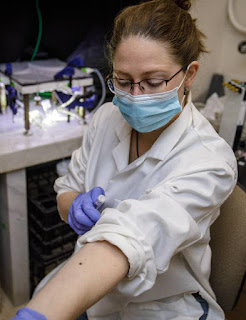Tick season nears. 10% of ticks carry debilitating diseases; quick action can prevent them. And UK wants you to send in your ticks!

—–
Ticks are a threat in Kentucky year-round, but especially in the summer months. The next time one bites you, stop and think before flushing it down the toilet. You could help other people by mailing it to the University of Kentucky entomology department to see if it carries disease or not.
Here’s how: If you find a tick on yourself or your pet, remove it with tweezers, place it in alcohol in a sealed container or bag, and mail it to the university’s entomology department. Those are the instructions Professor Reddy Palli, who chairs the department and serves as state entomologist, told Aaron Mudd of the Lexington Herald-Leader.
A university spokesperson told Mudd to check with your local UK Extension office to see exactly where to mail a specimen for study.
“We will contact the person who submits the specimen if we detect pathogens in the tick and encourage them to contact their physician,” Palli told the Herald-Leader in an email.
Mudd reports, “As a leader in his field, Palli is overseeing several researchers who are studying tick populations in Kentucky, monitoring the diseases they spread and potentially engineering ways to repel them or even stop them from searching for blood in the first place.”
She reports that one of the Palli’s graduate students is Anna Pasternak, who leads the Kentucky Tick Surveillance Program. She collects ticks analyze their genetic material and any disease-causing pathogens hiding within them. The program has been collecting information on ticks in the state since January 2019.
“Preliminary results show that the greatest number of ticks exist in wooded areas of the state and at Land Between the Lakes, and 10 percent of them carry a pathogen that cause diseases like Lyme disease, Rocky Mountain spotted fever, alpha-gal and others,” Palli said. The last disease he mentioned can cause an allergy to red meat.
Signs and symptoms of Lyme disease include fever, chills, headache, fatigue, muscle and joint aches and swollen lymph glands. Upwards of 80% of infected persons have a distinctive “bull’s eye” rash that appears at the site of the bite three to 30 days after infection.
The American dog tick and the brown dog tick can carry and transmit the bacteria that causes Rocky Mountain spotted fever.
Signs and symptoms of RMSF are fever, headache, nausea, vomiting, stomach pain, muscle pain, lack of appetite and a spotted rash. The rash usually develops several days after the onset of a fever and can vary between splotches and smaller pinpoint dots.
The Lone Star tick caries the bacteria that causes ehrilichiosis. Signs and symptoms of ehrilichiosis are fever, headache, chills, cough, malaise, muscle pain, nausea, vomiting, diarrhea, confusion and red eyes. A rash is common in children, but less so in adults.
The Lone Star tick is also a vector for alpha-gal syndrome, known as the red-meat allergy, which is becoming increasingly more common.
- Avoid grassy, wooded and leaf-covered areas
- Keep grass and shrubs trimmed and cleared away
- Walk in the center of walking trails
- Wear light-colored clothes, which make it easier to spot ticks
- Wear long pants tucked into boots and tuck in your shirts
- Use tick repellent that has the repellent DEET or picaridin
- Treat your clothes with permethrin, which repels and kills ticks
- Do a body check along the way and at the end of each day
- Check your pets and equipment for ticks
- Shower within two hours of potential exposure, if possible
To kill ticks on clothing, tumble dry for 10 minutes or wash them in hot water. If clothes can’t be washed in hot water, tumble dry for 90 minutes on regular heat or 60 minutes on high.
.png)